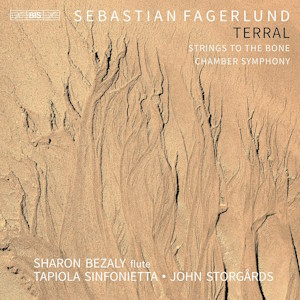
Sebastian Fagerlund (b. 1972)
Terral, flute concerto (2020/21)
Strings to the Bone (2014/15)
Chamber Symphony (2020/21)
Sharon Bezaly (flute)
Tapiola Sinfonietta/John Storgårds
rec. 2022, Tapiola Hall, Espoo, Finland
BIS BIS-2639 SACD [69]
Sebastian Fagerlund belongs to the generation of Finnish composers following Kaija Saariaho, Magnus Lindberg and Esa-Pekka Salonen. It is amazing how such a small country continues to turn out first class composers. He has been fortunate in being taken up by the recording company BIS, who have issued a number of recordings of his music, and you can find reviews of them on MWI. This is, however, my first encounter with his work.
The first work here, Terral, is a flute concerto. Fagerlund likes giving his concertos titles, and this one evokes the earth and ground but is also specifically the name for a land breeze in Spanish. The composer says ‘I thought about images, related to the material of the work, in which soil or sand take on a new appearance when blown by the wind. It’s about constant variation.’ It was written for the flautist Sharon Bezaly, who is the soloist here. It begins with the bewitching sound of the alto flute in the bottom of its register, which leads to a long line on the strings with arabesques and filigree work for the soloist, now on the standard instrument. In the middle of this first movement there is a faster section. The second movement is a kind of scherzo, setting up an insistent rhythm over which the soloist pirouettes and dances. The finale is loosely based on a passacaglia and also features a cadenza for the soloist. The whole work is attractive and easy to listen to, though I did not think it as being of any great depth.
Strings to the Bone is a single movement for string orchestra. This is an energetic and sinewy work, with Bartók’s Divertimento at some distance in the background. There is a constant pulse but also a gentler section with a long melody. Fagerlund acknowledges the influence of Ostrobothnian folk music in this work.
The Chamber Symphony is the most substantial work here. The form was invented by Schoenberg, whose first chamber symphony remains a classic. There are more recent examples by Enescu, Weinberg, Holmboe, John Adams and Thomas Adès, among others. Fagerlund’s orchestra is a Mozart-sized one, with duple wind and no heavy brass, plus a piano, which he uses rather in the manner of Prokofiev or Martinů. There are three movements, played without a break. The first movement is slow and opens with tuning up sounds which lead to a long melody. I fancy there is something of Sibelius in both the melody and the harmony here. There are two faster interludes. The second movement is fast and continues to use material from the first movement. The finale is slow and gradually integrates all the different material we have heard. This is an impressive work which does not give up its secrets readily.
John Storgårds is an experienced conductor of Fagerlund, having recorded his opera Höstsonaten (Autumn Sonata), and he conducts with conviction. Sharon Bezaly relishes the opportunities given her in Terral. The Tapiola Sinfonietta are just the right size for these works and play with their usual versatility. This is a SACD; however, I was listening in two-channel stereo, on which the recording was up to BIS’s usual high standards. The booklet is very helpful and I have drawn from it in this review. Fagerlund is worth following.
Stephen Barber
Previous review: Hubert Culot (August 2023)
Help us financially by purchasing from





















